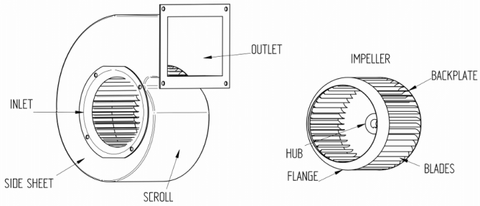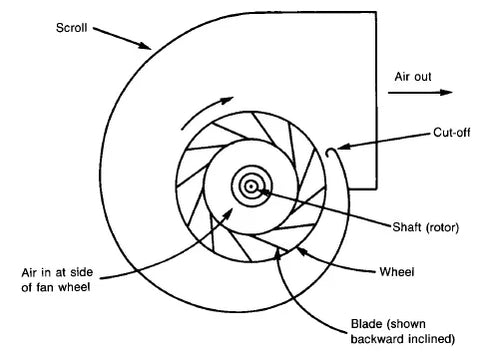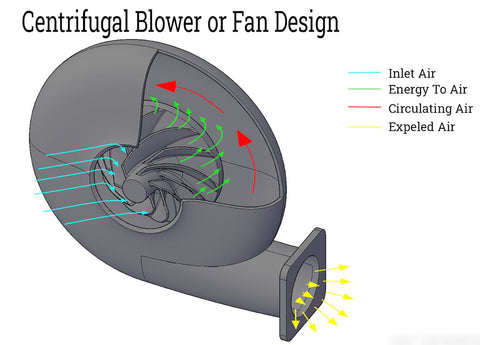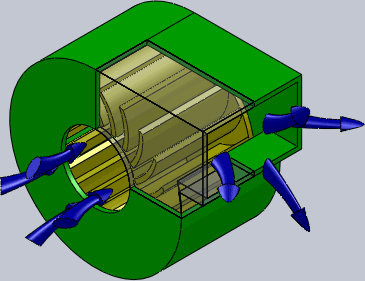A "squirrel cage" fan is a blower or fan commonly used in HVAC systems and named for its distinctive shape that resembles a hamster or squirrel wheel. The fan consists of a cylindrical cage that encloses a fan wheel, comprised of a set of blades (also known as vanes) arranged in a circular pattern around a central shaft. "Squirrel cage" fans go by several names, including centrifugal fan or blower, blower fan or blower wheel, cage fan, radial fan, rotary fan, snail fan, or scroll fan. Their application and design often determine the name they go by.

"Squirrel Cage" Fan Applications
These fans are used in a wide variety of applications due to their ability to move large volumes of air efficiently. They include:
- HVAC Systems: Commonly found in HVAC systems, they help distribute warm or cool air throughout a building.
- Industrial Processes: In many industries, these fans provide necessary ventilation, remove dust or fumes, cool machinery, or supply air for combustion processes.
- Electronics Cooling: Smaller "squirrel cage" fans are often used to cool electronic equipment, including servers, amplifiers, and high-end computer components.
- Drying & Dehumidification: These fans can be found in various drying systems, such as clothes dryers and dehumidifiers. They help to move moist air away from the material being dried.
- Air Purification Systems: Many air purifiers and fume extraction systems use squirrel cage fans to pull air through filters and scrubbers.
- Automobiles: These fans are used in car heating and cooling systems, blowing air through the heater core or evaporator coil and into the passenger compartment.
- Inflatable Structures: "Squirrel cage" fans can inflate large structures like bouncy castles or air-supported domes due to their ability to move large volumes of air.
These are just a few examples. The versatility of the "squirrel cage" fan design means it can be used in almost any application that requires moving air in a controlled manner.
Read more about AC Blower Motors.
How Does a "Squirrel Cage" Fan Work?
The fan is composed of a series of blades, or vanes, mounted around a central hub or shaft. This assembly is housed within a cylindrical enclosure, giving the fan its distinctive "cage-like" appearance.

When the electric motor attached to the fan is powered on, it rotates the central shaft, and the fan wheel begins to spin. As the wheel spins, it draws air from the sides toward the center. This incoming air is then subjected to the centrifugal force generated by the spinning wheel. Centrifugal force pushes the air outward along the blades and increases its speed.

The fan is designed so that the air doesn't exit from the sides; instead, it's redirected and escapes from the outer circumference of the fan wheel. Now traveling perpendicular to the air intake direction, this fast-moving air can be guided toward a specific location, such as into a duct or across a heat exchanger. This process allows a squirrel cage fan to move large volumes of air efficiently and quietly.

"Squirrel Cage" Fan FAQs
Which way should a "squirrel cage" fan spin?
The direction in which a squirrel cage fan spins depends on its design and the intended direction of airflow. Typically, when looking at the fan, it should spin so that it "scoops" air from the intake side and throws it out towards the output side.

However, there's no universal "correct" direction because different systems may require different airflow directions. The important thing is that the fan is spinning in the direction specified by the manufacturer to move air through the system properly. Look for arrows or markings on the fan or its housing indicating the intended direction of rotation and airflow to determine which way your fan should spin.
If a squirrel cage fan is not spinning in the correct direction (perhaps due to incorrect wiring), it can significantly decrease the system's efficiency and lead to overheating or other damage. So ensuring the fan is spinning in the correct direction is essential.
How do you clean a "squirrel cage" fan?
Cleaning a squirrel cage fan involves several steps. Here's a basic process, although the details may vary depending on the specific fan and its location within an appliance or system:
- Disconnect Power: Before cleaning or maintenance, always disconnect the power to the fan to ensure safety.
- Access the Fan: Remove any covers, ductwork, or other components blocking access to the fan.
- Visual Inspection: Before cleaning, do a quick visual inspection to check for any visible damage or wear that might need attention.
- Vacuum Loose Debris: Use a vacuum cleaner to remove loose dust and debris from the fan. Use a brush attachment if you have one, as it can help dislodge dust stuck to the blades.
- Brush Cleaning: For more stubborn dirt, use a soft brush or cloth to clean each blade. Be gentle to avoid damaging the blades.
- Compressed Air: If the blades are still not clean, consider using compressed air to dislodge the dust.
- Deep Cleaning: If the blades are very dirty and the above methods aren't sufficient, you may need to remove the fan for deep cleaning. This typically involves unscrewing the fan from its mount and then cleaning the blades with a suitable cleaner and cloth. Be sure to dry the blades thoroughly before reassembling them.
- Reassembly & Testing: After cleaning and drying, reassemble the fan, reconnect the power, and test the fan to ensure it works properly.
Always refer to the manufacturer's instructions for cleaning and maintaining your fan.
Shop "Squirrel Cage" Fans Online
Liberty Supply offers a variety of "squirrel cage" fans from manufacturers such as Trane, Daikin, York, Lennox, Carrier, AAON, Johnson Controls, Honeywell, and more.

